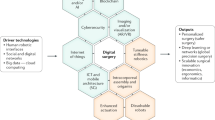Abstract
There is an increasing demand for minimally invasive surgery, despite any controversy over whether patients benefit from minimally invasive procedures rather than undergoing open surgery. In the field of urology, the performance of more complicated procedures is still a challenge even for experienced laparoscopic surgeons. Recently, robots have been introduced to enhance operative performance, increase applicability and precision of laparoscopy, and improve the learning curve for complicated minimally invasive procedures. With the introduction of master–slave systems where the surgeon is seated remotely from the robot and uses controls to maneuver the mechanical arms placed inside the patient, a new development in robot-assisted surgery has commenced. Several authors have suggested that surgical robots similar to the da Vinci Surgical System® (Intuitive Surgical, Sunnyvale, CA), which have three-dimensional (3D) vision and wristed instruments thus giving a greater degree of freedom than rigid laparoscopic instruments, will facilitate the outcome of these more challenging laparoscopic procedures. Whether these features will translate into better functional and oncological results remains to be evaluated. Data published so far clearly suggest that the patient will benefit from less postoperative pain, decreased bleeding and a shorter hospital stay compared with open surgery, and that the surgeon benefits from a faster learning curve than for conventional laparoscopy. For the benefit of our patients and for the development of urology it is vital that we understand both the limitations of telerobotics and when it is appropriate to incorporate these new techniques in day-to-day urologic surgery.
This is a preview of subscription content, access via your institution
Access options
Subscribe to this journal
Receive 12 print issues and online access
$209.00 per year
only $17.42 per issue
Buy this article
- Purchase on Springer Link
- Instant access to full article PDF
Prices may be subject to local taxes which are calculated during checkout


Similar content being viewed by others
References
Clayman RV et al. (1991) Laparoscopic nephrectomy: initial case report. J Urol 146: 278–282
Gettman MT et al. (2003) Current status of robotics in urologic laparoscopy. Eur Urol 43: 106–112
Schuessler WW et al. (1997) Laparoscopic radical prostatectomy: initial short-term experience. Urology 50: 854–857
Guillonneau B et al. (1999) Laparoscopic radical prostatectomy: technical and early oncological assessment of 40 operations. Eur Urol 36: 14–20
Abbou CC et al. (2000) Laparoscopic radical prostatectomy: preliminary results. Urology 55: 630–634
Moinzadeh A and Gill IS (2004) Laparoscopic radical cystectomy with urinary diversion. Curr Opin Urol 14: 83–87
Bann S et al. (2003) Robotics in surgery. J Am Coll Surg 196: 784–795
Kwoh YS et al. (1988) A robot with improved absolute positioning accuracy for CT guided stereotactic brain surgery. IEEE Trans Biomed Eng 35: 153–160
Borner M et al. (1999) Computer-assisted surgery for hip endoprosthesis. Z Arztl Fortbild Qualitatssich 93: 253–258
Kavoussi LR et al. (1994) Telerobotic assisted laparoscopic surgery: initial laboratory and clinical experience. Urology 44: 15–19
Kavoussi LR et al. (1995) Comparison of robotic versus human laparoscopic camera control. J Urol 154: 2134–2136
Guillonneau B (2003) What robotics in urology? A current point of view. Eur Urol 43: 103–105
Sung GT and Gill IS (2001) Robotic laparoscopic surgery: a comparison of the da Vinci and Zeus systems. Urology 58: 893–898
Menon M et al. (2002) Laparoscopic and robot assisted radical prostatectomy: establishment of a structured program and preliminary analysis of outcomes. J Urol 168: 945–949
Gill IS et al. (2000) Robotic remote laparoscopic nephrectomy and adrenalectomy: initial experience. J Urol 164: 2082–2085
Hubert J (2003) Robotic pyeloplasty. Curr Urol Rep 4: 124–129
Ahlering TE et al. (2003) Successful transfer of open surgical skills to laparoscopic environment using a robotic interface: initial experience with laparoscopic radical prostatectomy. J Urol 170: 1738–1741
Tewari A et al. (2002) Technique of da Vinci robot-assisted anatomic radical prostatectomy. Urology 60: 569–572
Menon M et al. (2003) Nerve-sparing robot-assisted radical cystoprostatectomy and urinary diversion. BJU Int 92: 232–236
Beecken WD et al. (2003) Robotic-assisted laparoscopic radical cystectomy and intra-abdominal formation of an ortotopic ileal neobladder. Eur Urol 44: 337–339
Menon M et al. (2004) Robot-assisted radical cystectomy and urinary diversion in female patients: technique with preservation of the uterus and vagina. J Am Coll Surg 198: 386–393
Menon M (2003) Robotic radical retropubic prostatectomy. BJU Int 91: 175–176
Rassweiler J et al. (2003) Laparoscopic versus open radical prostatectomy: a comparative study at a single institution. J Urol 166: 1689–1693
Hoznek A et al. (2001) Laparoscopic radical prostatectomy: the Créteil experience. Eur Urol 40: 38–45
El-Feel A et al. (2003) Laparoscopic radical prostatectomy-an analysis of factors affecting operating time. Urology 62: 314–318
Sarle R et al. (2004) Surgical robotic and laparoscopic training drills. J Endourol 18: 66–67
Bentas W et al. (2003) Robotic technology and the translation of open radical prostatectomy to laparoscopy: the early Frankfurt experience with robotic radical prostatectomy and one year follow-up. Eur Urol 44: 175–181
Guillonneau B et al. (2002) Perioperative complications of laparoscopic radical prostatectomy: the Montsouris 3-year experience. J Urol 167: 51–56
Tü rk I et al. (2001) Laparoscopic radical prostatectomy: technical aspects and experience with 125 cases. Eur Urol 40: 46–53
Dahl DM et al. (2002) Laparoscopic radical prostatectomy: initial 70 cases at a U.S. university medical center. Urology 60: 859–863
Tewari A et al. (2003) A prospective comparison of radical retropubic and robot-assisted prostatectomy: experience in one institution. BJU Int 92: 205–210
Ahlering TE et al. (2004) Robot-assisted versus open radical prostatectomy: a comparison of one surgeon's outcomes. Urology 63: 819–822
Noldus J et al. (2003) Treatment of prostate cancer: the clinical use of radical prostatectomy. EAU Update Series 1: 16–22
Gregori A et al. (2003) Laparoscopic radial prostatectomy: perioperative complications in an initial and consecutive series of 80 cases. Eur Urol 44: 190–194
Hemal AK et al. (2003) Laparoscopic radical cystectomy and ileal conduit reconstruction: preliminary experience. J Endourol 17: 911–916
Guazzoni G et al. (2003) Laparoscopic nerve- and seminal-sparing cystectomy with orthotopic ileal neobladder: the first three cases. Eur Urol 44: 567–572
Simonato A et al. (2003) Laparoscopic radical cystoprostatectomy: a technique illustrated step by step. Eur Urol 44: 132–138
McGinnis DE et al. (2004) Hand-assisted laparoscopic cystoprostatectomy and urinary diversion. J Endourol 18: 383–386
Balaji KC et al. (2004) Feasibility of robot-assisted totally intracorporeal laparoscopic ileal conduit urinary diversion: initial results of a single institutional pilot study. Urology 63: 51–55
Hemal AK et al. (2004) Complications of laparoscopic cystectomy during the initial experience. Int J Urol 11: 483–488
Sanderson KM et al. (2004) The evolving role of pelvic lymphadenectomy in the treatment of bladder cancer. Urol Oncol 22: 205–211
Ghoneim MA and Abol-Eneim H (2004) Lymphadenectomy with cystectomy: is it necessary and to what is its extent. Eur Urol 46: 457–461
Artibani W et al. (2003) Is laparoscopic radical prostatectomy better than traditional retropubic radical prostatectomy? An analysis of peri-operative morbidity in two contemporary series in Italy. Eur Urol 44: 401–40655
Author information
Authors and Affiliations
Corresponding author
Ethics declarations
Competing interests
The author declares no competing financial interests.
Rights and permissions
About this article
Cite this article
Wiklund, N. Technology Insight: surgical robots—expensive toys or the future of urologic surgery?. Nat Rev Urol 1, 97–102 (2004). https://doi.org/10.1038/ncpuro0055
Received:
Accepted:
Issue Date:
DOI: https://doi.org/10.1038/ncpuro0055
This article is cited by
-
Robot-assisted and conventional urology surgical procedures: comparison of average length of stay, economic status, operative time and patient’s expenditure in a tertiary care hospital of North India
Journal of Robotic Surgery (2022)
-
Hersentumoren op kinderleeftijd
Tijdschrift voor Kindergeneeskunde (2011)
-
The current status of robotic pelvic surgery: results of a multinational interdisciplinary consensus conference
Surgical Endoscopy (2009)



